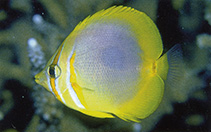| Family: |
Chaetodontidae (Butterflyfishes) |
| Max. size: |
16 cm TL (male/unsexed) |
| Environment: |
reef-associated; brackish; marine; depth range 5 - 15 m, non-migratory |
| Distribution: |
Western Pacific: northern Australia, from Western Australia to the Great Barrier Reef; New Guinea and perhaps further into Melanesia. Very closely related to Chaetodon rainfordi and the two species are sympatric over part of their ranges. |
| Diagnosis: |
Dorsal spines (total): 11-11; Dorsal soft rays (total): 20-22; Anal spines: 3-3; Anal soft rays: 17-18; Vertebrae: 24-24. Description: Body nearly circular. Preopercle obtuse-angled, smooth to finely serrate. Eye diameter is greater than snout length. Dorsal and anal fins strongly and equally rounded and do not appear confluent with caudal fin. Pelvic fins long, extending as far as second anal fin spine base. Juveniles similar in shape to adults. Axillary scale present. Color: Eye bands join at nape and extend to chest as two indistinct lines, the anterior lines again joined. Indistinct dark bordered light stripe in interorbital (Ref. 4855). Snout length 2.8-3.2 in HL. Body depth 1.2-1.5 in SL (Ref. 90102). |
| Biology: |
Inhabit coastal and inner reefs; juveniles among branching corals. Solitary or paired (Ref. 9710). Oviparous (Ref. 205). Form pairs during breeding (Ref. 205). Hybridizes with Chaetodon rainfordi (Ref. 90102). |
| IUCN Red List Status: |
Least Concern (LC); Date assessed: 07 October 2009 Ref. (130435)
|
| Threat to humans: |
harmless |
Source and more info: www.fishbase.org. For personal, classroom, and other internal use only. Not for publication.
